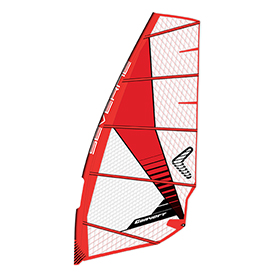
SEVERNE CONVERT 6.7M 2019 TEST REVIEW
SEVERNE CONVERT 6.7M 2019 TEST REVIEW
OVERVIEW
Labelled by Severne as their ‘value freeride’ offering, the name of the Convert gives a good idea itself of the sail’s brief and intent – to transition the user into the world of planing windsurfing, and ensure they’re hooked for life! Designed with the key focus of being easy to use, the most striking visual attribute of the Convert is the large Dacron panel that radiates from the clew, widening as it diffuses up the sail. Rigged on a 100% 460 SDM, it is certainly effortless to rig, requiring very little tension to satisfy its minimal luff curve. In fact, it easily has the least curvature in the test group, and doesn’t really even require the aid of a rig puller, the carefully oriented tack pulley helping to mitigate any undue friction whilst downhauling. Dacron also features in the Convert’s luff panel, whilst the rest of the sail’s panels are made of widely spaced x-ply. Set to the increments specified, the two lower battens rest with plenty of rotation around the mast, as the leech falls away evenly down to batten four. At rest it exhibits a small amount of shape below the boom, but remains flat and neutral above the boom. Build is clean and uncomplicated, with a real sense that features are dispensed with unless they add cost effective value. Integrated batten pockets and a seamless foot panel are adopted for example over unnecessary graphical niceties and frills.
BRAND CLAIM
“The Convert is packed with features including a dropped clew for shorter, more manageable boom lengths. The shaping and geometry are set up for a balanced, stable feel and a forward pulling drive for a relaxed, easy stance.”
PERFORMANCE
With a luff of 466 cm, the Convert is the tallest sail here, its upright posture exposing it to the wind as best it can to catch all the power possible. Couple this with the minimalist luff curve and the Convert springs to life early and excitedly as soon as there is enough pressure. It can be pumped easily, albeit taking care not to over-sheet, the low clew position and raked boom orientation making it easy for an energetic pilot to overcook it. Alternatively just keep it at arm’s reach and let the sail breathe into shape, the stretch in the luff panel helping the sail’s profile to deepen, and the power to build progressively. The drive from the Convert is certainly soft and forgiving, its centre of effort relatively high and focussed around the rider to provide useful feedback, whilst the Dacron wedge through the heart of the sail determines the nature of the delivery. Stand up and relax into it, or lock it down and push the board, the Convert has an interesting blend of attributes that give it the versatility to accommodate various riding styles. A master for making the most of light to medium wind strengths, it can be recalibrated with more tension to remain useable in powered to overpowered conditions. The leech twists off smoothly down to the dropped clew, and the profile’s stability is certainly not an embarrassment; yet the flex in the upper Dacron panels can be felt in gusts, making the rider question its suitability. Instead the Convert makes a rewarding partner for the progressing rider, guiding them seamlessly through core planing and transitional skills.
THE VERDICT
A fantastic tutor for the light to medium weight rider that wants hassle free enjoyment, the X-Tra offers light handling and forgiveness over an impressive range.
Other sails in this test:


